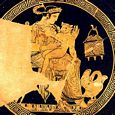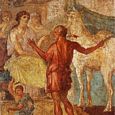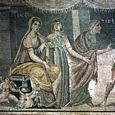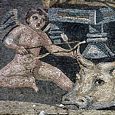PASIPHAE
Greek Name
Πασιφαη
Transliteration
Pasiphaê
Latin Spelling
Pasiphae
Translation
All-Shining (pasi, phainô)
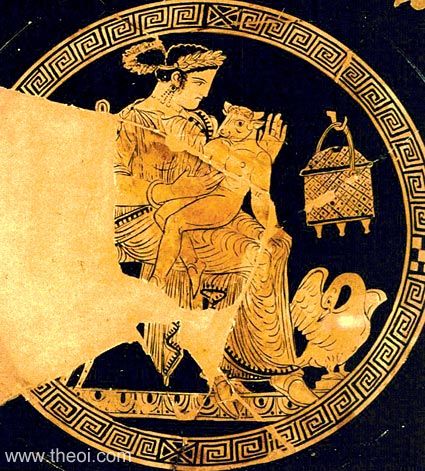
PASIPHAE was an immortal daughter of the sun-god Helios. Like her siblings, Aeetes and Kirke (Circe), she was a skilled practitioner of witchcraft (pharmakeia).
Pasiphae married King Minos of Krete (Crete) and bore him a number of sons and daughters. As punishment for some offence against the gods--committed either by herself or her husband--she was cursed with lust for the king's finest bull. The queen enlisted the help of the artisan Daidalos (Daedalus) who built her an animate, wooden cow wrapped in bovine-skin. Hidden inside the contraption she coupled with the bull and conceived a hybrid child--the bull-headed Minotauros (Minotaur).
Pasiphae's husband King Minos also proved unfaithful. When she learned of his indiscretions she bewitched him, causing him to ejaculate poisoned creatures and destroy his lovers. Pasiphae herself, being an immortal, was alone immune to the spell. Minos was later cured by the Athenian girl Prokris (Procris) who devised a remedy for the strange afflication.
Pasiphae was an early Kretan moon-goddess similar to the classical Selene. Both her taurine lover and her Minotaur son--who was also named Asterios (Starry One)--were associated with the constellation Taurus.
FAMILY OF PASIPHAE
PARENTS
[1.1] HELIOS & PERSEIS (Apollodorus 1.80, Cicero De Natura Deorum 3.19)
[1.2] HELIOS (Apollonius Rhodius 3.997, Antoninus Liberalis
41, Hyginus Fabulae 40, Ovid Metamorphoses 9.737, Seneca Phaedra 112)
[1.3] HELIOS & KRETE (Diodorus Siculus 4.60.4)
OFFSPRING
[1.1] THE MINOTAUROS (by the Kretan
Bull) (Apollodorus 3.8, Diodorus Siculus 4.77.1, Philostratus the Elder 1.16,
Hyginus Fabulae 40, Ovid Metamorphoses 8.132, Seneca Phaedra 112, Nonnus Dionysiaca 47.395, Suidas)
[2.1] KATREUS, DEUKALION, GLAUKOS, ANDROGEOS, AKALLE, XENODIKE, ARIADNE,
PHAIDRA (by Minos) (Apollodorus 3.7)
[2.2] ARIADNE, DEUKALION, KATREUS, ANDROGEUS (by Minos) (Diodorus Siculus 4.60.4)
[2.3] ARIADNE (by Minos) (Apollonius Rhodius
3.997)
[2.4] IDOMENEUS (by Minos) (Pausanias 5.25.9)
[2.5] ASTERIOS (by Minos) (Nonnus Dionysiaca 40.290)
[2.6] DEUKALION (by Minos) (Hyginus Fabulae 14)
[2.7] PHAEDRA, ARIADNE (by Minos) (Ovid
Heroides 4.53 & 157, Seneca Phaedra 112)
ENCYCLOPEDIA
PAST′PHAE (Pasiphaê). 1. A daughter of Helios and Perseis, and a sister of Circe and Aeetes, was the wife of Minos, by whom she was the mother of Androgeos, Catreus, Deucalion, Glaucus, Minotaurus, Acalle, Xenodice, Ariadne, and Phaedra. (Apollon. Rhod. iii. 999, &c.; Apollod. i. 9. § 1, iii. 1. § 2; Ov. Met. xv. 501 ; Cic. De Nat. Deor. iii. 19; Paus. v. 25. § 9.) 2. An oracular goddess at Thalamae in Laconia, was believed to be a daughter of Atlas, or to be the same as Cassandra or Daphne, the daughter of Amyclas. People used to sleep in her temple for the purpose of receiving revelations in dreams. (Plut. Agis, 9; Cic. De Dir. i. 43.)
Source: Dictionary of Greek and Roman Biography and Mythology.
CLASSICAL LITERATURE QUOTES
PARENTAGE & CHILDREN OF PASIPHAE
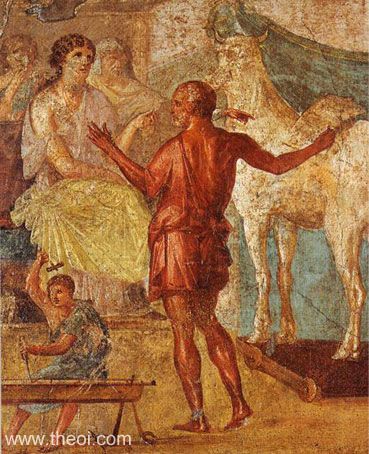
Pseudo-Apollodorus, Bibliotheca 1. 80 (trans. Aldrich) (Greek mythographer C2nd A.D.)
:
"The Kholkians (Colchians) who were ruled by Aeetes, the son of Helios and Perseis, and brother of Kirke
(Circe) and Minos' wife Pasiphae."
Pseudo-Apollodorus, Bibliotheca 3. 7 :
"Minos, residing in Krete (Crete), passed laws, and married Pasiphae, daughter of Helios and Perseis . . .
He begat sons, to wit, Katreus (Catreus), Deukalion (Deucalion), Glaukos (Glaucus), and Androgeus: and
daughters, to wit, Akalle (Acalle), Xenodike (Xenodice), Ariadne, Phaidra (Phaedra)."
Apollonius Rhodius, Argonautica 3. 997 ff (trans. Rieu) (Greek epic C3rd B.C.)
:
"Remember Ariadne, young Ariadne, daughter of Minos and Pasiphae, who was a daughter of Helios."
Apollonius Rhodius, Argonautica 3. 1074 ff :
"[Medea addresses Iason (Jason) :] ‘Tell me too about that girl [Ariadne] you mentioned, who won such
fame for herself, the daughter of Pasiphae my father's [Aeetes'] sister.’"
Diodorus Siculus, Library of History 4. 60. 4 (trans. Oldfather) (Greek historian
C1st B.C.) :
"[Minos] marrying Pasiphae, the daughter of Helios and Krete (Crete), he begat Deukalion (Deucalion) and
Katreus (Catreus) and Androgeus and Ariadne and had other, natural, children more in number than these."
Pausanias, Description of Greece 5. 25. 9 (trans. Jones) (Greek travelogue C2nd A.D.)
:
"Idomeneus the descendant of Minos. The story goes that Idomeneus was descended from Helios (the Sun), the
father of Pasiphae."
Pseudo-Hyginus, Fabulae 14 (trans. Grant) (Roman mythographer C2nd A.D.) :
"Deucalion, son of Minos and Pasiphae, daughter of Sol [Helios], from Crete."
Cicero, De Natura Deorum 3. 19 (trans. Rackham) (Roman rhetorician C1st B.C.)
:
"Circe and Pasiphae and Aeetes, the children of Perseis the daughter of Oceanus by Sol [Helios]."
Ovid, Heroides 10. 91 ff (trans. Showerman) (Roman poetry C1st B.C. to C1st A.D.)
:
"[Ariadne daughter of Pasiphae speaks :] ‘I , whose father is Minos, whose mother [Pasiphae] the
child of Phoebus [Helios the Sun].’"
Nonnus, Dionysiaca 40. 290 ff (trans. Rouse) (Greek epic C5th A.D.) :
"He [the Kretan (Cretan) prince Asterios] avoided the Knossian (Cnossian) city and the sons of his family,
hating Pasiphae and his own father Minos."
MINOS & THE WITCHCRAFT OF PASIPHAE
Pseudo-Apollodorus, Bibliotheca 3. 197 - 198 (trans. Aldrich) (Greek mythographer
C2nd A.D.) :
"[Prokris (Procris)] fled to Minos, who wanted her and tried to persuade her to have sex with him. But if a
woman had sex with Minos, she could not be saved; for after he had slept with many women, Pasiphae put him under
a spell whereby, whenever he went to bed with another woman, he would ejaculate wild creatures into her vagina,
thus killing her. Even so, in return for the fleet hound and the straight-hitting javelin that Minos owned, and
after giving him a potion made from the Kirkaian (Circaean) root to keep him from hurting her, she went to bed
with him."
Antoninus Liberalis, Metamorphoses 41 (trans. Celoria) (Greek mythographer C2nd A.D.)
:
"Prokris (Procris) forsook Kephalos (Cephalus) and went off as a fugitive to Minos the king of Krete
(Crete). She found on arrival that he was afflicted by childlessness and promised a cure, showing him how to
beget children. Now Minos would ejaculate snakes, scorpions and millipedes, killing the women with whom he had
intercourse.
But his wife Pasiphae, daughter of Helios the Sun, was immortal. Prokris accordingly devised the following to
make Minos fertile. She inserted the bladder of a goat into a woman and Minos first emitted the snakes into the
bladder; then he went over to Pasiphae and entered her. And when children were born to them, Minos gave Prokris
his spear and his dog. No animal could escape these two and they always reached their target."
PASIPHAE, THE CRETAN BULL & BIRTH OF THE MINOTAUR
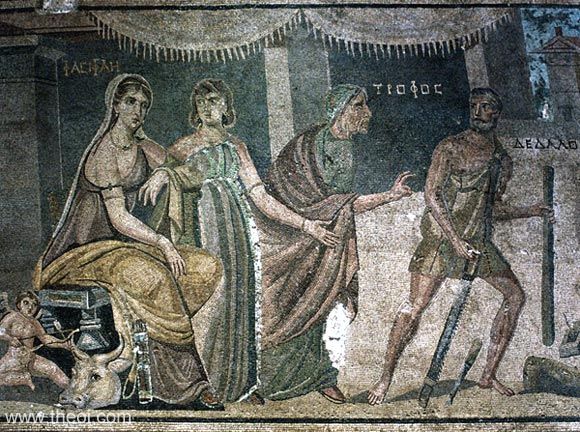
Bacchylides, Fragment 26 (from Papyrus) (trans. Campbell, Vol. Greek Lyric IV)
(Greek lyric C5th B.C.) :
"Pasiphae . . ((lacuna)) Kypris (Cypris) [Aphrodite] implanted desire in her . . ((lacuna)) : to Eupalamos'
son Daidalos (Daedalus), most skilled of carpenters, she told her unspeakable sickness [i.e. lust for a bull];
she made him swear a binding oath and ordered him to build a wooden cow, so that she might join her body to that
of the mighty bull, hiding from Minos . . ((lacuna)) the union she shared."
Pseudo-Apollodorus, Bibliotheca 3. 8 - 11 (trans. Aldrich) (Greek mythographer C2nd
A.D.) :
"Minos aspired to the throne [of Krete (Crete)], but was rebuffed. He claimed, however, that he had
received the sovereignty from the gods, and to prove it he said that whatever he prayed for would come about. So
while sacrificing to Poseidon, he prayed for a bull to appear from the depths of the sea, and promised to
sacrifice it upon its appearance. And Poseidon did send up to him a splendid bull. Thus Minos received the rule,
but he sent the bull to his herds and sacrificed another . . .
Poseidon was angry that the bull was not sacrificed, and turned it wild. He also devised that Pasiphae should
develop a lust for it. In her passion for the bull she took on as her accomplice an architect named Daidalos
(Daedalus) . . . He built a wooden cow on wheels, . . . skinned a real cow, and sewed the contraption into the
skin, and then, after placing Pasiphae inside, set it in a meadow where the bull normally grazed. The bull came
up and had intercourse with it, as if with a real cow. Pasiphae gave birth to Asterios (Asterius), who was
called Minotauros (Minotaur). He had the face of a bull, but was otherwise human. Minos, following certain
oracular instructions, kept him confined and under guard in the labyrinth. This labyrinth, which Daidalos built,
was a cage with convoluted flextions that disorders debouchment.”
Callimachus, Hymn 4 to Delos 311 ff (trans. Mair) (Greek poet C3rd B.C.) :
"[Theseus] having escaped the cruel bellowing and the wild on of Pasiphae and the coiled habitation of the
crooked labyrinth."
Diodorus Siculus, Library of History 4. 13. 4 (trans. Oldfather) (Greek historian
C1st B.C.) :
"The next Labour which Herakles undertook was to bring back from Krete (Crete) the bull of which, they say,
Pasiphae had been enamoured."
Diodorus Siculus, Library of History 4. 77. 1 :
"Now according to the myth which was handed down to us Pasiphae, the wife of Minos, became enamoured of the
bull, and Daidalos (Daedalus), by fashioning a contrivance in the shape of a cow, assisted Pasiphae to gratify
her passion. In explanation of this the myths offer the following account: before this time it had been the
custom of Minos annually to dedicate to Poseidon the fairest bull born in his herds and to sacrifice it to the
god; but at the time in question there was born a bull of extraordinary beauty and he sacrificed another from
among those which were inferior, whereupon Poseidon becoming angry at Minos, caused his wife Pasiphae to become
enamoured of the bull. And by means of the ingenuity of Daidalos Pasiphae had intercourse with the bull and gave
birth to the Minotauros (Minotaur), famed in the myth. This creature, they say, was of double form, the upper
parts of the body as far as the shoulders being those of a bull and the remaining parts those of a man. As a
place in which to keep this monstrous thing Daidalos, the story goes, built a labyrinth, the passage-ways of
which were so winding that those unfamiliar with them had difficulty in making their way out; in this labyrinth
the Minotaur was maintained and here it devoured the seven youths and seven maidens which were sent to it from
Athens, as we have already related.
But Daidalos, they say, on learning that Minos had made threats against him because he had fashioned the cow,
became fearful of the king and departed from Krete (Crete), Pasiphae helping him and providing and vessel for
his escape . . . But certain writers of myths have the following account: Daidalos remained a while longer in
Krete, being kept hidden by Pasiphae, and king Minos, desiring to wreak bengeance upon him and yet being unable
to find him, caused all the boats which were on the island to be searched and announced that he would give a
great sum of money to the man who should discover Daidalos. Thereupon Daidalos, despairing of making his escape
by any boat, fashioned with amazing ingenuity wings whish were cleverly designed and marvellously fitted
together with wax."
Philostratus the Elder, Imagines 1. 16 (trans. Fairbanks) (Greek rhetorician C3rd
A.D.) :
"[Ostensibly a description of an ancient Greek painting at Neapolis (Naples) :] Pasiphae is in love with
the bull and begs Daidalos (Daedalus) to devise some lure for the creature; and he is fashioning a hollow cow
like a cow of the herd to which the bull is accustomed. What their union brought forth is shown by the form of
the Minotauros (Minotaur), strangely composite in its nature. Their union is not depicted here, but this is the
workshop of Daidalos; and about it are statues, some with forms blocked out, others in a quite complete state in
that they are already stepping forward and give promise of walking about [i.e. Daidalos was a crafter of animate
statues]. Before the time of Daidalos, you know, the art of making statues had not yet conceived such a thing.
Daidalos himself is of the Attic type in that his face suggests great wisdom and that the look of the eye is so
intelligent; and his very dress also follows the Attic style; for he wears this dull coarse mantle and also he
is painted without sandals, in a manner peculiarly affected by the Athenians. He sits before the framework of
the cow and he uses Erotes (Love-Gods) as his assistants in the device so as to connect with it something of
Aphrodite . . .
Pasiphae outside the workshop in the cattlefold gazes on the bull, thinking to draw him to her by her beauty and
by her robe, which is divinely resplendent and more beautiful than any rainbow. She has a helpless look--for she
knows what the creature is that she loves --and she is eager to embrace it, but takes no notice of her and gazes
at its own cow. The bull is depicting with proud mien, the leader of the herd, with splendid horns, white,
already experienced in love, its dewlap low and its neck massive, and it gazes fondly at the cow; but the cow in
the herd, ranging free and all white but for a black head, disdains the bull. For its purpose suggests a leap,
as of a girl who avoids the importunity of a lover."
Pseudo-Hyginus, Fabulae 30 (trans. Grant) (Roman mythographer C2nd A.D.) :
"The bull with which Pasiphae lay he [Heraces] brought alive from the island of Crete to Mycenae."
Pseudo-Hyginus, Fabulae 40 :
"Pasiphae, daughter of Sol [Helios] and wife of Minos, for several years did not make offerings to the
goddess Venus [Aphrodite]. Because of this Venus [Aphrodite] inspired in her an unnatural love for a bull. At
the time when Daedalus came there as an exile, he asked her to help him. For her he made a wooden heifer, and
put in it the hide of a real heifer, and in this she lay with the bull. From this intercourse she bore the
Minotaur, with bull's head but human body. Then Daedalus made for the Minotaur a labyrinth with an
undiscoverable exit in which it was confined. When Minos found out the affair he cast Daedalus into prison, but
Pasiphae freed him from his chains."
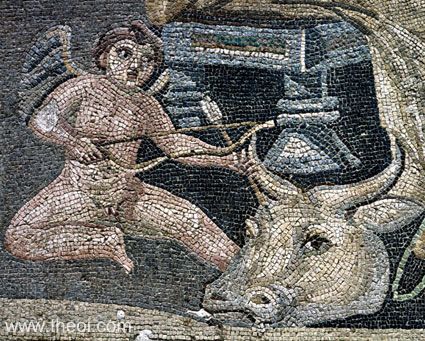
Ovid, Metamorphoses 8. 130 ff (trans. Melville) (Roman epic C1st B.C. to C1st A.D.)
:
"[Skylla (Scylla) princess of Megara addresses King Minos :] ‘Fit mate were you of that adulteress
who in a cow of wood beguiled a savage bull and bore a monster [the Minotaur] in her womb! Do my words reach
your rears or do the winds blow them to waste? . . . No wonder your Pasiphae preferred her bull to you: you were
the fiercer beast.’ . . . His [Minos'] dynasty's disgrace has grown; the monstrous beast [the Minotaur]
hybrid beast declared the queen's obscene adultery."
Ovid, Metamorphoses 9. 735 ff :
"Crete should lack no monstrous birth, [Pasiphae] the daughter of Sol (the Sun) [Helios] once loved a
Bull--a female with a male . . . her love had hope; her Bull, tricked by that bogus cow, served her--she had a
male to lead astray."
Ovid, Fasti 3. 499 ff (trans.Boyle) (Roman poetry C1st B.C. to C1st A.D.)
:
"The horns of a handsome bull captured my [Ariadne's] mother [Pasiphae]."
Ovid, Heroides 4. 53 ff (trans. Showerman) (Roman poetry C1st B.C. to C1st A.D.)
:
"[Phaedra daughter of Pasiphae laments :] ‘It may be this love is a dept I am paying, due to the
destiny of my line, and that Venus [Aphrodite] is exacting tribute of me for all my race . . . Pasiphaë my
mother, victim of the deluded bull, brought forth in travail her reproach and burden.’"
Ovid, Heroides 4. 165 ff :
"[Phaedra addresses' Hippolytos :] ‘My mother [Pasiphae] could pervert a bull; will you be fiercer
than a savage beast?’"
Virgil, Aeneid 6. 24 ff (trans. Day-Lewis) (Roman epic C1st B.C.) :
"Crete rising out of the waves; Pasiphae, cruelly fated to lust after a bull, and privily covered; the
hybrid fruit of that monstrous union--the Minotaurus (Minotaur), a memento of her unnatural love."
Propertius, Elegies 2. 32 (trans. Goold) (Roman elegy C1st B.C.) :
"Once was the wife of mighty Minos [Pasiphae], so they say, seduced by the snow-white form of a glowering
bull."
Propertius, Elegies 3. 19 :
"She [Pasiphae] who suffered the disdain of a Cretan Bull and put on the false horns of a timber cow."
Propertius, Elegies 4. 7 :
"For two abodes have been appointed [for the ghosts of the impious dead] along the foul river [Akheron
(Acheron)], and the whole host rows this way or that. One passage conveys the adulterous Clytemnestra, and
carries the Cretan queen [Pasiphae] whose guile contrived the wooden monstrosity of a cow."
Seneca, Phaedra 112 ff (trans. Miller) (Roman tragedy C1st A.D.) :
"[Phaedra daughter of Pasiphae laments :] ‘I recognize my wretched mother's [Pasiphae's] fatal curse;
her love and mine know how to sin in forest depths. Mother, my heart aches for thee; swept away by ill
unspeakable, thou didst boldly love the wild leader of the savage herd [the bull]. Fierce was he and impatient
of the yoke, lawless in love, leader of an untamed herd; yet he did love something. But as for me, what god,
what Daedalus could ease my wretched passion? Though he himself should return, mighty in Attic cunning, who shut
our monster [the Minotaur] in the dark labyrinth, he could afford no help to my calamity. Venus [Aphrodite],
detesting the offspring of the hated Sol (the Sun) [Helios], is avenging through us the chains that bound her to
her loved Mars [Ares], and loads the whole race of Phoebus [Helios] with shame unspeakable.’"
Seneca, Phaedra 173 ff :
"[The nurse of Phaedra addresses her mistress :] ‘Why do monsters cease? Why does thy brother's [the
Minotaur's] labyrinth stand empty? Shall the world hear of strange prodigies, shall nature's laws give way,
whenever a Cretan woman [i.e. such as Pasiphae] loves?’"
Seneca, Phaedra 687 ff :
"O thou [Phaedra], who hast outshined the whole race of women, who hast dared a greater evil than thy
monster-bearing mother [Pasiphae], thou worse than she who bore thee! She did but pollute herself with her
shameful lust, and yet her offspring by its two-shaped infamy [the Minotaur] displayed her crime, though long
concealed, and by his fierce visage the hybrid child made clear his mother's guilt. That was the womb that bore
thee."
Nonnus, Dionysiaca 47. 395 ff (trans. Rouse) (Greek epic C5th A.D.) :
"[Ariadne speaks of her mother Pasiphae :] ‘My mother too once was the menial of a farmer [i.e.
hidden inside an animated wooden cow ], and bowed her neck for a herdsman, and prattled love to a dumb bull in
the pasture, and brought the bull a calf [the Minotaur]. She cared not to hear the herdsman make music on his
pipe so much as to hear the bellowing bull.’"
Suidas s.v. En panti muthoi kai to Daidalou musos (trans. Suda On Line) (Byzantine
Greek Lexicon C10th A.D.) :
"En panti muthoi kai to Daidalou musos--In every myth there is also the defilement of Daidalos
(Daedalus) : It is said that Pasiphae was in love with a bull and begged Daidalos to make a wooden cow and rig
it up and put her in it; and mounting her like a cow, the bull made her pregnant. From her the Minotauros
(Minotaur) was born . . . Since the origin and blame for these evils were attributed to Daidalos and he was
loathed for them, he became the subject of the proverb."
CULT OF PASIPHAE
Pausanias, Description of Greece 3. 26. 1 (trans. Jones) (Greek travelogue C2nd A.D.)
:
"From Oitylos (Oetylus) to Thalamai (Thalamae) [in Lakonia] the road is about eighty stades long. On it is
a sanctuary of Ino and an oracle. They consult the oracle in sleep, and the goddess reveals whatever they wish
to learn, in dreams. Bronze statues of Pasiphae and of Helios (the Sun) stand in the unroofed part of the
sanctuary. It was not possible to see the one within the temple clearly, owing to the garlands, but they say
this too is of bronze. Water, sweet to drink, flows from a sacred spring. Pasiphae is a title of Selene (the
Moon), and is not a local goddess of the people of Thalamai."
Cicero, De Natura Deorum 3. 19 (trans. Rackham) (Roman rhetorician C1st B.C.)
:
"[Cicero's philosophical critique on the nature of the gods :] If Ino is to be deemed divine . . . because
she is the daughter of Cadmus, are Circe and Pasiphae and Aeetes, the children of Perseis the daughter of
Oceanus by Sol (the Sun) [Helios], to be not counted in the list of gods? . . . If these are not divine, I have
my fears as to what will become of Ino, for the claims of all of them derive from the same source."
Suidas s.v. Pasiphae (trans. Suda On Line) (Byzantine Greek lexicon C10th A.D.)
:
"Pasiphae : Name of a goddess."
ANCIENT GREEK & ROMAN ART
SOURCES
GREEK
- Greek Lyric IV Bacchylides, Fragments - Greek Lyric C5th B.C.
- Apollodorus, The Library - Greek Mythography C2nd A.D.
- Apollonius Rhodius, The Argonautica - Greek Epic C3rd B.C.
- Callimachus, Hymns - Greek Poetry C3rd B.C.
- Diodorus Siculus, The Library of History - Greek History C1st B.C.
- Pausanias, Description of Greece - Greek Travelogue C2nd A.D.
- Antoninus Liberalis, Metamorphoses - Greek Mythography C2nd A.D.
- Philostratus the Elder, Imagines - Greek Rhetoric C3rd A.D.
- Nonnus, Dionysiaca - Greek Epic C5th A.D.
ROMAN
- Hyginus, Fabulae - Latin Mythography C2nd A.D.
- Ovid, Metamorphoses - Latin Epic C1st B.C. - C1st A.D.
- Ovid, Fasti - Latin Poetry C1st B.C. - C1st A.D.
- Ovid, Heroides - Latin Poetry C1st B.C. - C1st A.D.
- Propertius, Elegies - Latin Elegy C1st B.C.
- Cicero, De Natura Deorum - Latin Rhetoric C1st B.C.
- Seneca, Phaedra - Latin Tragedy C1st A.D.
BYZANTINE
- Suidas, The Suda - Byzantine Greek Lexicon C10th A.D.
BIBLIOGRAPHY
A complete bibliography of the translations quoted on this page.
